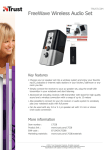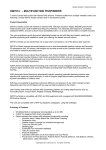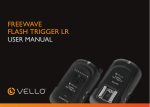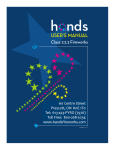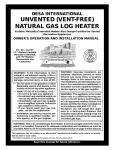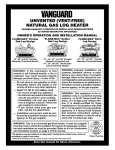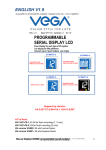Download User Manual - B&H Photo Video Digital Cameras, Photography
Transcript
FREEWAVE FUSION PRO USER MANUAL 2 INTRODUCTION Thank you for choosing the Vello FreeWave Fusion Pro Wireless Shutter/ Flash/Grouping Remote. This device triggers off-camera lights remotely from up to 600 feet (183m) away. With its multiple groups feature, you can easily configure up to three different light groups, which can be triggered individually or simultaneously, for a total of seven different combinations. (Simultaneous triggering of multiple light groups requires additional FreeWave Fusion Pro Receivers, available for purchase separately.) Additionally, the FreeWave Fusion Pro incorporates the conveniences of a wireless shutter release, allowing you to trip the shutter without disturbing the camera. It’s ideal for taking pictures of subjects that are difficult to approach, such as wildlife. It also eliminates vibrations caused by pressing your camera’s shutter release button during macro, close-up, and long-exposure photography. The FreeWave Fusion Pro Transmitter features a hot shoe mount that supports through-the-lens (TTL) data pass-through. With the Transmitter mounted onto your camera, you can mount your compatible flash directly onto the Transmitter, allowing your camera to set the appropriate flash level automatically The FreeWave Fusion Pro does not require line-of-sight alignment, as its radio waves pass through and around objects such as walls, windows, and floors. KEY FEATURES 2.4GHz Radio Frequency: Reduced interference and improved wireless signal quality. Extended Range: up to 600 feet (183m) Multi-Purpose: Use as an individual or group wireless flash trigger, and/or as a shutter release remote trigger. Multiple Groups: Configure up to three different light groups and up to seven different group combinations. Flash Sync Speed of up to 1/200s: Take advantage of sync speeds that match the rating of your camera all the way up to 1/200s (on compatible cameras only). Flash Wake-Up: Wake-up function in TTLcompatible flash units. Versatile: One Receiver works with multiple camera and light models. Just swap out the connecting cables. Dual-Function Shutter Release Button: Press halfway to focus; press fully to trigger shutter. LED Indicators: Confirm pre-focus, shutter release, flash wake-up, and flash trigger in wireless mode. TTL Pass-Through: The Transmitter lets TTL data transfer from your camera to your compatible flash, allowing your camera to set the appropriate flash level automatically, in conjunction with its TTL metering system. Your Vello FreeWave Fusion Pro Wireless Shutter/Flash/Grouping Remote Kit contains: Wireless Transmitter Wireless Receiver Shutter Release Cable 3.5 mm Mini to 3.5 mm Mini Studio Trigger Cable (3.5 mm Mini to ¼″ Phono) 4 AAA Batteries 2 Hot Shoe Protectors Receiver Holder 4 COMPATIBLE DEVICES The FreeWave Fusion Pro Transmitter features a hot shoe mount that supports TTL data pass-through, allowing your camera to set the appropriate flash level automatically, in conjunction with its TTL metering system. In order to take advantage of the TTL feature, you will need full TTL support via your camera, and a compatible flash. When transmitting data to the flash or studio light in any way other than the Transmitter’s hot shoe mount, we recommend using a fully manually- controlled flash. Because these methods do not transmit TTL settings, you will need to set the power output manually. The FreeWave Fusion Pro is compatible with most cameras, flash units, and studio lights. However, for TTL pass-through via the Transmitter, flash wake-up functionality, and/or high shutter speeds, you will need full TTL support via your camera, flash, and FreeWave Fusion Pro trigger. For instance, if you have a Canon camera and you’d like to take advantage of the flash wake-up feature, you will need a Canon camera with TTL metering, a compatible Canon flash which supports TTL, and a dedicated Canon-compatible FreeWave Fusion Pro flash trigger. Similarly, if you have a Nikon camera and you’d like to take advantage of the flash wake-up feature, you will need a Nikon camera with TTL metering, a compatible Nikon flash which supports TTL, and a dedicated Nikon-compatible FreeWave Fusion Pro flash trigger. 5 SAFETY WARNINGS • There are no user-serviceable parts inside the devices. Do not attempt to disassemble or perform any unauthorized modification. • Do not operate the FreeWave Fusion Pro in the presence of flammable gas or vapors. • Do not handle with wet hands or immerse in or expose to water or rain. Failure to observe this precaution could result in fire or electric shock. • Keep out of the reach of children. This device contains small parts which may pose a choking hazard. • Observe caution when handling batteries. Batteries may leak or explode if improperly handled. Use only the batteries listed in this manual. Make certain to align batteries with correct polarity. • Batteries are prone to leakage when fully discharged. To avoid damage to the product, be sure to remove the batteries when leaving the product unattended for prolonged periods or when no charge remains. • Do not use or leave the devices in conditions of extreme heat, severe cold, or high humidity. • Turn off the camera’s power before inserting or removing the remote cord. • Dispose of used batteries, packaging, and old devices in accordance with appropriate local environmental regulations. 6 FEATURES DIAGRAM Transmitter Confirmation LED Receiver Power / Setting Button Shutter Release Button Power / (Group) Switch Group Indicator 3.5 mm Output Jack Channel Switch Hot Shoe Mount 7 BEFORE YOU BEGIN Set the channel switch located on the side of the Transmitter and Receiver. The channel switches set a different radio frequency for each Transmitter/Receiver set, so that multiple sets of the FreeWave Fusion Pro and/or additional Fusion Pro Receivers can be used simultaneously. You can set the channel switches to your desired code; Any combination will work so long as the switches are set identically for both the Transmitter and Receiver(s) of a single FreeWave Fusion Pro set. Insert 2 AAA batteries in the Receiver and in the Transmitter. Transmitter Receiver Identical Channel 8 POWERING UP Turn ON the Receiver: Turn ON the Transmitter: Slide the Group Switch to either A, B, or C and the unit will power up. The LED will flash red at 2 second intervals to indicate that the Receiver is working. Press and hold the power button for 2 seconds to power up the Transmitter. The Group Indicator light will turn on and show the currently selected group. The Group indicator light will turn off after 2 seconds and the Transmitter will enter Standby mode. To power down after use, slide the Group Switch back to the Off position. To power down after use, press and hold the power button for 2 seconds. The LED at the top of the unit will flash 4 times at half-second intervals to indicate that it is powering down. 9 MOUNTING THE TRANSMITTER 1. With your camera and Receiver off, loosen the Transmitter’s hot shoe locking ring. 2. Insert the Transmitter’s hot shoe into the camera’s hot shoe mount. 3. Tighten the hot shoe locking ring until secure. 10 MOUNTING THE RECEIVER Mount the receiver on your tripod or stand via one of the two provided mounting options: 1. Threaded socket for a standard ¼″ screw mount 2. Accessory shoe (cold shoe) foot 11 CONNECTING THE LIGHTS Connecting to a Flash Unit: Connecting to a Studio Light 1. Switch the flash’s locking switch to the unlock position You will need to use the included Studio Trigger Cable to connect the Receiver to a studio light. 2. Insert the flash’s hot shoe foot into the Transmitter or Receiver’s hot shoe mount 3. Switch the flash’s locking switch to the locked position 1. Plug the 3.5 mm end of the cable into the Receiver’s output jack. 2. Plug the 3.5 mm end of the cable into the studio light remote jack 3. If your studio light has a ¼″ phono jack, it will need to be connected using the included 3.5 mm to ¼″ phono cable. 12 SETTING THE GROUPS Slide the Receiver’s Group/Power switch to either A, B, or C. To assign multiple Receivers to the same flash group, simply select the same group letter for each Receiver in the flash group. The LED at the top of the Receiver will flash red to confirm that the power is on. Tip: You can combine studio lights and speedlights within the same flash group. (Be aware of the independent recycling time of each flash to ensure all flash units are ready to fire). 13 SELECTING THE GROUPS 1. Gently press the Group/Power button on the Transmitter. The group indicator LED(s) will light up to indicate which groups are currently selected. 2. To change group selections, press the Group/Power button again. Keep pressing the Group/Power button to cycle through all the Group options: A only; B only; C only; A, B and C; A and B; A and C; B and C. 3. To see which groups are currently selected at any time, gently press the Group/Power button. The Group indicator light will turn off after 2 seconds. However, even after powering down, the transmitter will remember the last group selected. 4. To verify light and group selection, press the shutter release button on either the camera or the FreeWave Pro Transmitter halfway. The LED at the top of the Receiver will turn green on each currently selected Receiver. 14 USING THE FLASH TRIGGER 1. Confirm that the power on your camera, Transmitter, and Receiver is turned on. 2. If your flash has a wake-up function: Press the shutter button on the camera halfway to wake your flash. 3. If your flash does not have a wakeup function, you may be able to turn off sleep mode: Refer to your flash’s manual to find out if you can turn off sleep mode and for instructions. 4. Fully press the shutter button on your camera. All lights connected to Receivers in the currently selected group will fire. Note: When transmitting data to the flash or studio light through anything other than the Transmitter’s hot shoe mount, we recommend using a fully manuallycontrolled flash. Because these methods do not transmit TTL settings, you will need to set the power output manually. 15 USING THE FREEWAVE FUSION PRO AS A REMOTE SHUTTER RELEASE Connecting the Camera: To use the remote shutter release function, you will need to use the included Fusion Pro shutter release cable. 1. Plug the 3.5 mm end of the cable into the Receiver. 2. Plug the other end of the cable into your camera’s shutter release terminal. 3. Mount the Receiver on your camera’s hot shoe facing forwards or backwards. If you are using your camera’s hot shoe, you can use an accessory shoe to attach the Receiver to your camera, tripod, or other suitable surface. Note: If you are mounting a flash on your camera, mount the flash directly on your camera’s hot shoe. The Fusion Pro Receiver can be mounted on a straight bracket. DO NOT MOUNT THE FLASH ON TOP OF THE FUSION PRO RECEIVER since the Receiver does not send TTL signals to the flash. 16 REMOTE SHUTTER RELEASE | SINGLE SHOTS 1. Turn on the Receiver by sliding the Group/Power switch to any position other than Off. 2. Set your camera to the single-shot setting. 3. Press and hold the Transmitter’s shutter release button halfway to wake or focus your camera (if set to Auto Focus). The LED will turn green. 4. Fully depress the shutter button on the Transmitter. The LED will turn red and the shutter will be triggered. 17 REMOTE SHUTTER RELEASE | CONTINUOUS MODE 1. Turn on the Receiver by sliding the Group/Power switch to any position other than Off. 2. Set your camera to the continuous shooting mode. 3. Press and hold the Transmitter’s shutter release button halfway to wake or focus your camera (if set to Auto Focus). The LED will turn green. 4. A full press of the Transmitter’s shutter button will trigger the camera to take continuous photos until you release the shutter button. 18 REMOTE SHUTTER RELEASE | SELF-TIMER MODE 1. Turn on the Receiver by sliding the Group/Power switch to any position other than Off. 2. Set your camera to the delay/self-timer setting. 3. Press and hold the Transmitter’s shutter release button halfway to wake or focus your camera (if set to Auto Focus). The LED will turn green. 4. Fully depress the shutter button on the Transmitter. The LED will turn red and the shutter will be triggered after the pre-set delay set in your camera. 19 REMOTE SHUTTER RELEASE | BULB MODE (LONG EXPOSURE) 1. Turn on the Receiver by sliding the Group/Power switch to any position other than Off. 2. Set your camera to the bulb setting. 3. Press and hold the Transmitter’s shutter release button halfway to wake or focus your camera (if set to Auto Focus). The LED will turn green. 4. Press and hold the Transmitter’s shutter button. The shutter will remain open until you release the shutter button. 20 CAMERA RELEASE CABLES Please see the included compatibility sheet for a list of compatible trigger cables from the Gradus Group. 21 SPECIFICATIONS Transmitter Receiver Power 2 AAA 2 AAA Battery Life* 5 Years 250 Hours Channel Settings Range 4 possible channels 600 ft. (183m) with no obstructions Frequency 2.4 GHz Confirmation LEDs 2 Color * In standby mode. Transmitter Flash Trigger Groups Lights per Group Shutter Modes (settings controlled by camera) Receiver 7 possible groups: A, B, C, ABC, AB, AC, BC Unlimited Single Shot, Continuous, Self-Timer, & Bulb 22 TROUBLESHOOTING Problems with the FreeWave Fusion Pro can usually be traced to the following most common causes. Perform the following steps to diagnose and correct the problem: Check the contact between the light’s hot shoe foot and the Receiver’s hot shoe. Make sure the light’s locking switch is set to the lock position. Check that the shutter release cable and/ or studio light cable are in good condition and properly connected. Make sure that the Receiver is powered on and at the correct setting. Remove the batteries from the Transmitter and Receiver and change the channel by switching the channel switches to a different combination, taking care to ensure that both the Transmitter and Receiver are set identically. If you encounter any interference on the initial setting, try changing the channel by choosing a different channel switch combination. When using the FreeWave Fusion Pro as a shutter release, you may not be able to release the shutter on your camera if the lens is set to Auto Focus and cannot focus on the subject. Switch your camera to manual focus to ensure proper shutter release. 23 FCC COMPLIANCE This equipment generates, uses, and can radiate radio frequency energy, and if not installed and used in accordance with the instructions, may cause harmful interference to radio communications. This equipment has been tested and found to comply with the limits for a Class B digital device pursuant to Part 15 of the FCC Rules. These limits are designated to provide reasonable protection against harmful interference in a residential installation. If this equipment does cause harmful interference to radio or television reception, which can be determined by turning the equipment ON or OFF, the user is encouraged to try to correct the interference by one or more of the following measures: There is no guarantee that interference will not occur in a particular installation. This device complies with Part 15, Subpart B, Class B of the FCC Rules. 1. Reorient or relocate the receiving antenna; 2. Increase the distance between the equipment and the receiver. Operation is subject to the following two conditions: 1. This device may not cause harmful interference. 2. This device must accept any interference received, including interference that may cause undesired operation. Any changes or modifications (including the antenna) made to this device that are not expressly approved by the manufacturer may void the user’s authority to operate the equipment. Limited One-Year Warranty Vello provides a limited warranty that this product is free from defects in materials and workmanship to the original purchaser under normal use for a period of one (1) year from the original purchase date, or thirty (30) days after replacement whichever occurs later. Vello's responsibility with respect to this limited warranty shall be limited solely to repair or replacement, at its option, of any product which fails during normal consumer use. This warranty does not extend to damage or failure which results from misuse, neglect, accident, alteration, abuse, improper installation or maintenance. EXCEPT AS PROVIDED HEREIN, VELLO MAKES NEITHER ANY EXPRESS WARRANTIES NOR ANY IMPLIED WARRANTIES. INCLUDING BUT NOT LIMITED TO ANY IMPLIED WARRANTY OF MERCHANTABILITY OR FITNESS FOR A PARTICULAR PURPOSE.To obtain a replacement during the time of this warranty please return the defective Item with proof of purchase along with an RMA number to the place of purchase. This warranty gives you specific legal rights, and you may also have other rights which vary from state to state. © Copyright 2013 Gradus Group
























